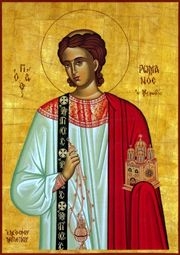
Our Prophet Elias Choir, led by Lara Willingham, brings a peaceful and prayerful atmosphere for Divine Liturgy and Feast Days. Our choir chants the hymns of the Church will all our hearts, and feel blessed to do so.
Shout joyfully to the Lord, all the earth; break forth in song, rejoice, and sing praises.
– Psalm 98:4
Music is inseparable from our worship. Participation as a chanter or choir member is not a performance, but a great responsibility to educate the faithful and enrich our services. In the ancient tradition, voices are the instruments, although some parish choirs have piano or organ accompaniment. Prophet Elias has an a cappella choir.
Dr. Nicholas Itsines, First Chanter or Psalti, and Lara Willingham, Choir director, chant Orthros many a Sunday morning together. They provide leadership and training for our choir members.
Prayers and hymns are sung and chanted in Greek and English to remind us of sacrifices made for our salvation. Special hymns on holy days honor the Saint or event honored during the Divine Liturgy.
The Byzantine musical system has been part of Orthodox hymnology from the first centuries of the Church. The earliest Christians songs were based on the psalms and canticles from the Old Testament. Original hymns were chanted by a solo chanter called a “psalti.”
Saint Romanos the Melodist was one of the greatest of Greek hymnographers, called “the Pindar of rhythmic poetry.” He flourished during the sixth century, which is considered to be the Golden Age of Byzantine hymnography.
In the eighth century, St. John of Damascus codified  a system of eight musical styles, selected because they were not too theatrical or worldly, and helped create a prayerful attitude in the faithful. Still in use today, the system is called the “ochoechos” (eight tones) and hymns written in these tones are rotated weekly for the Divine Liturgy.
a system of eight musical styles, selected because they were not too theatrical or worldly, and helped create a prayerful attitude in the faithful. Still in use today, the system is called the “ochoechos” (eight tones) and hymns written in these tones are rotated weekly for the Divine Liturgy.
Over time, these tones have taken on a two-part character, which adds a second voice (often called the “ison”) that drones on the tonal center against the melody. Simply, the ison is the floor on which the melody dances.
Harmonized music is a later addition to the Divine Liturgy. Although it appeared as early as the 16th century in other ethnic Orthodox churches, it did not make its entrance into the Greek Orthodox Church until the nineteenth century.
Byzantine chant is stark for a reason – it eliminates all the excess in the music and cuts to the core. Further, there is a link between Byzantine chant and iconography. The iconographer uses strict conventions to create art that invokes a spiritual experience, not a sensual one. The same is true for the Byzantine hymnographer.
Information from…www.newbyz.org
The choir welcomes people of all ages to sing the hymns to the glory of God in the holy services. If you are interested, please contact Choir Director Lara Willingham at (831) 429-6500.
SAMPLE: Byzantine Notation with English translation
